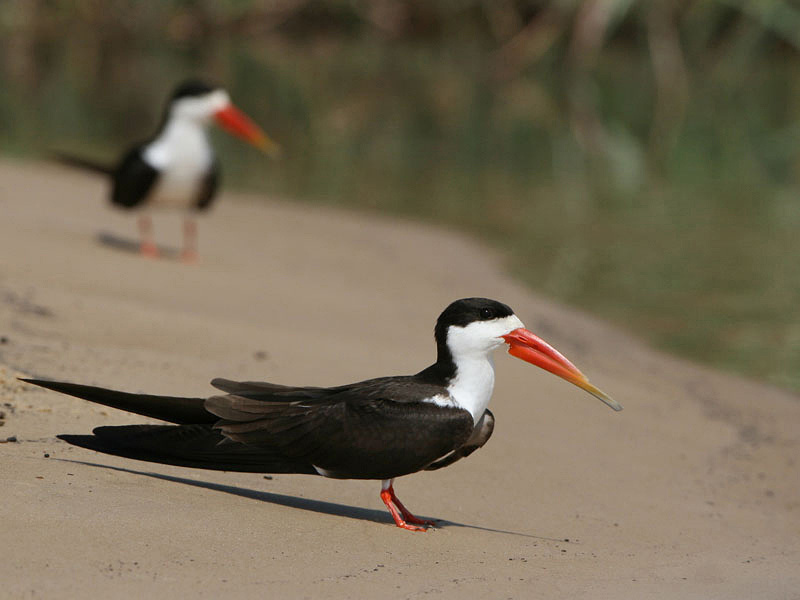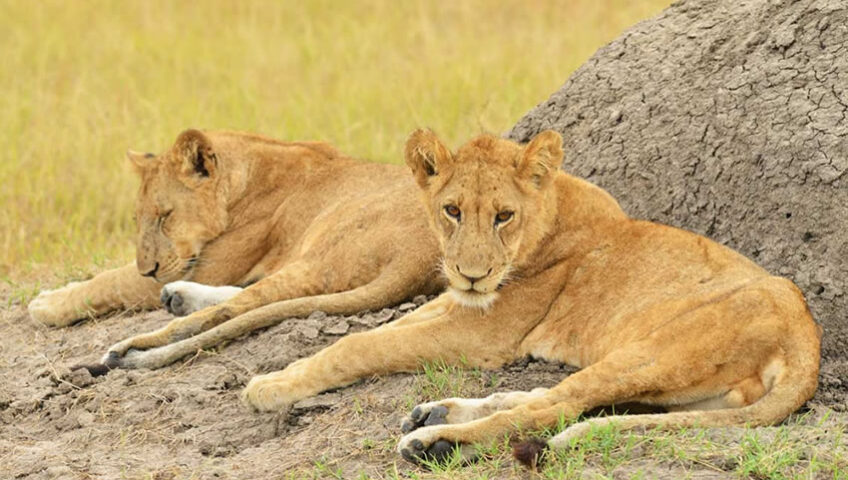Queen Elizabeth National Park : The most spectacular and second-largest national park in Uganda after Murchison Falls National Park, Queen Elizabeth National Park is situated in the southwest in the Kasese area at the foot of the magnificent Rwenzori mountain ranges.
Lake George and Lake Edward are close by the park. The park is home to a variety of animals, including the tree-climbing lion, waterbuck, Uganda kobs, and warthogs, all of which are frequently seen in and near the park’s entrance. You can also expect to see many elephants, hippopotamuses, and leopards lounging in the sun.
There are many different types of inhabitants in the open savannah grassland, lakes, wetland, and woods, including many mammals, primates, water animals, and four of the big five. But after two years, when Queen Elizabeth II paid a visit to the park, it was renamed Kazinga National Park. The park was first established in 1952.
It is the most popular travel destination among other tour locations because it is Uganda’s most well-known wildlife reserve with distinctive physical characteristics. The park is located in the southwest of Kampala, the capital city of Uganda, and its lowland area is estimated to be 1978 square kilometers.
There are over 95 different mammal species in Queen Elizabeth National Park, including elephants, lions, buffaloes, Uganda Kobs, African bush leopards, water animals like hippos and crocodiles, and many more. “The tree climbing lions” are unique to this park and cannot be found in any other national park in Uganda.
The park is home to 600 different bird species, including swamp flycatchers, palm-nut vuttures, pel’s fishing owls, spotted Redshanks, yellow-throated cuckoos, crab-plovers, collared pratincoles, and many more. The park’s principal attractions are best seen in five of its boundary sectors, which are the highlights of an African adventure: the Ishsa sector, the Mweya Peninsula, the Kazinga Channel, the Maramagambo Forest, and the Kyambura Gorge.
When visiting the park, visitors can participate in a variety of enjoyable activities, such as game drives, nature walks, bird watching, mongoose tracking, lions that scale trees, chimpanzee tracking, boat cruises, cave visits, and visits to Katwe Salt Lake, among others. You will have an exceptional and unforgettable experience when seeing Queen Elizabeth National Park thanks to all these activities.
Game drive
This is the most exciting thing you can do in Kasenyi Plain, where you may observe the most exquisite wildlife that characterizes an African journey when you go to Queen National Park. The best time to go on a game drive is early in the day when the park’s attractions allow you to see the park’s wild creatures up close. You will travel in a safari vehicle with a knowledgeable guide who follows you about and leads you on a quest for various wild species. Enjoying your game drive will reward you with incredible spot viewing of animals like elephants with ears that resemble the continent of Africa, lions hunting Uganda kobs, warthogs, leopards, and numerous buffalo herds, among others, that you may encounter while on the game drive.
Lion tracking
Lion tracking, which entails following the lion using cell phones in the Kasenyi Plains, appears to be the second intriguing activity that appeals to tourists. This is an incredibly moving experience being conducted by experts from the Uganda Carnivore Program. It is primarily done in the open savanna of the Kasenyi plain giving you enough information about African lions and also giving you a chance to see the king of the jungle with your own eyes, watching as they prey on Uganda kobs for their daily meal. In order to prevent disturbances in their natural habitat and to provide a thrilling lion tracking experience, lion tracking in Queen Elizabeth National Park is done with a small group of people. Each participant must pay USD 50 for lion tracking.
Chimpanzee tracking
The incredible activity of chimpanzee tracking has helped the park become well-known for its gorillas. The largest crevasse in East Africa, Kyambura Gorge, situated in the north of Queen Elizabeth National Park, where this activity can be carried out.Chimpanzees, as well as other tiny primates like Red-tailed monkeys and baboons, are known to live in the Kyambura Gorge. If you’re tracking, you may also be able to see lovely birds. The most thrilling activity you can participate in is chimpanzee tracking. Permits for tracking chimpanzees cost $150 per person.
Bird watching
The park is one of the best places to go on birding safaris because it is home to over 600 different bird species. This activity can be done in Maramangambo Forest, where visitors can see rare birds like the palm-nut vutture, spotted red shank, yellow-winged tera, African finfoot, African hobby, African skimmer, Black bee-eater, Caspian plover, Great blue turaco, and Great white pygmy goose while listening to

Boat cruise
Queen Elizabeth National Park offers boating excursions along the Kazinga Channel, a natural waterway that joins Lake Edward and Lake George. One has the opportunity to witness water wildlife throughout the voyage on the waterway, including several hippos swimming in the channel and Nile crocodiles basking in the sun on the channel’s banks. These will all be once-in-a-lifetime experiences that you can have on the cruise.
Mongoose tracking:
This is a fantastic activity that can be done along the hike as you encounter at kazinga channel in the Mweya peninsula. It takes 3 hours to get to the mongoose study area with a guide, where you may see this unusual mongoose and learn about its lifestyle, habits, and behavior.
Nature walks
In the Maramagambo Forest, which is home to several primates and birds, one can go on nature walks. You may see tree species that have been present on the park’s grounds for many years while strolling through the forest. You can also explore the caves that are hidden within the forest, where you can see a large number of bats.
Packing list for Queen Elizabeth National Park Uganda Safari
Because of Uganda’s temperate climate, it occasionally rains at night or in the morning after the sun has set during the day. If you want to visit one of Uganda’s national parks, including Queen Elizabeth National Park, you can drive yourself there. Warm garments, sweaters, lighting gear, mineral water bottles, hiking boots, tents, waterproof bags, pants, and long sleeved shirts are just a few of the essentials you should take with your personal items.
Best time to visit the Queen Elizabeth National Park
The best time to visit the park is during the dry seasons, when the primates paths are less slippery and the vast savanna grassland is drier for easier vehicle mobility along the nature habitant of wildlife. Uganda has two seasons, the dry season and the wet season. You can visit the park during the rainy seasons, especially if you enjoy going on birding safaris. Because the forest is greener and more abundant in food during this season, you can see the secret haven that birds call their woodland home. Wet seasons run from March to May and September to December, while dry months run from June to September and December to February.
Accommodation in Queen Elizabeth National Park
In addition to being the most popular park, it features excellent and pleasant lodging options, with prices varying depending on the facility, location, and amenities. Simba Safari Camp, Irungu Forest Safari Lodge, Mweya Safari Lodge, Kasenyi Safari Camp, Queen Elizabeth Park View Tourist Lodge, Engiri Game Lodge and campsite, Tembo Safari Lodge, Buffalo Safari Lodge, Marafiki Safari Lodge, and others are a few of the lodging options in Queen Elizabeth National Park.
Getting to Queen Elizabeth National Park
The quickest and most convenient way to get to the park is by plane, which takes one hour and twenty minutes to travel from Kajjasi Airstrip along Entebbe Road to Mweya Airstrip, which is close to the park. It takes 5 hours 30 minutes to go by vehicle from Kampala, the capital of Uganda, to the major attraction.

